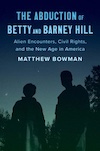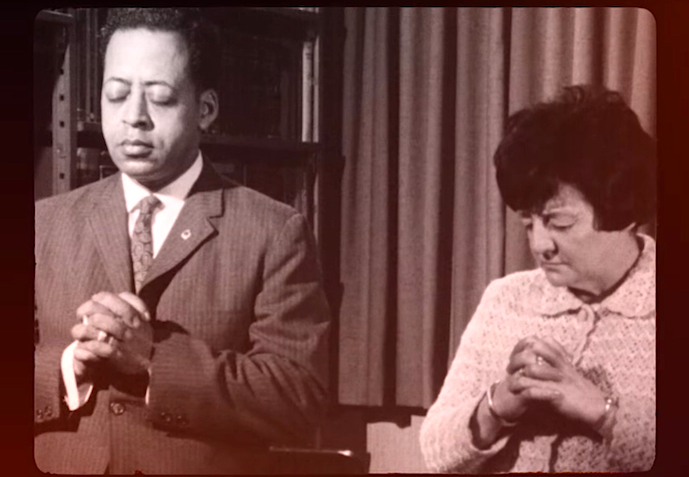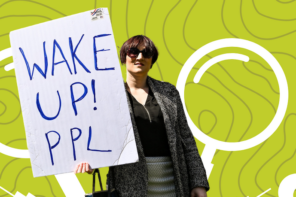In 1961, driving back from a short vacation, Betty and Barney Hill encountered a bright cigar-shaped light on the highway that moved erratically before appearing to chase them. They fled and then told their story, which later became the first case of claimed alien abduction in the US. In his new book, The Abduction of Betty and Barney Hill, historian Matthew Bowman reads their story as a microcosm of social and spiritual tumult during the 1960s.

The Abduction of Betty and Barney Hill: Alien Encounters, Civil Rights, and the New Age in America
Matthew Bowman
Yale U. Press
Aug, 2023
The Hills’ sighting came during the period when ‘flying saucers’ were crystallizing in the public imagination as a form of technology created and flown by advanced beings from other planets. The U.S. military designated such sightings unidentified flying objects—a more scientific and precise term intended to create distance from flying saucer rhetoric—and now calls them unidentified aerial phenomena (UAP), another distancing maneuver.
UAPs are big news again with recent congressional hearings in which a whistleblower testified that that non-human life exists, craft have crashed on Earth, and the military is involved in a vast cover up of their existence. Bowman connects the Hills’ to more recent sightings, such as the Tic Tac-shaped craft spotted by navy pilots in 2004, since which time the government office tracking UAPs has recorded more than 500 sightings. It has also been revealed that the Advanced Aerospace Threat Identification Program, or AATIP, part of the Pentagon, received $22 million in funding to track and investigate UAPs. These recent developments suggest a ripe time to turn back to the Hills.
UFOs and neoliberalism
Bowman reads the material as a story of how Americans lost trust in institutions like the military, science, and government. Cynicism grew as the New Deal broke down and the civil rights movement foundered, and conspiracy theories thrived in these tears in the social contract. Indeed, stories of flying saucers do tell us something about America. As far as academic scholarship on UFO stories goes, this is the normative approach.
In reading UFOs as symbols of cultural turmoil, something quintessentially American, Bowman follows the same approach as can be found in existing works by Jodi Dean, Bridget Brown, and Susan Lepselter. Where Bowman’s work differs is that he roots the personal history of Betty and Barney Hill in the context of postwar social and political change and finds correspondence with the historical shift from state support of welfare policies and economic regulation to neoliberalism that occurred alongside diminishing trust in authority and increasing belief in conspiracy theories.
The text is largely focused on recounting the narrative of the Hills’ lives through multiple accounts. Using the Hills’ own writings, largely unpublished, alongside transcripts of interviews about their sighting, an investigation by a local newspaper, and a published account by journalist John Fuller from 1966, Bowman meticulously relays the differing versions of the story.
Accounts from interviews under hypnosis provide much more detail and elaboration than earlier versions in which they see a strange light and flee in terror. Under hypnosis they claimed, years later, that creatures from the craft had kidnapped them and performed medical experiments. The approach produces a Rashomon effect, in which the same events are told and retold from different perspectives, with details added or removed.
Bowman uses his skills as a historian to painstakingly relate the plurality of narratives without impugning the Hills, as many have, although the effect for the reader can, at times, be stultifying. Still, the text provides carefully researched details of how the stories evolved and how the Hills themselves changed along with their retellings. Bowman describes how Betty Hill was born in the New Deal era and showed an early commitment to labor unions and liberalism, and how Barney Hill, whose family had moved during the Great Migration, became active in the civil rights movement.
This attention to detail does a service to the Hills, who are often treated reductively, and provides an enlightening history of mid-twentieth century America read through an ordinary American couple who happened to tell a story of how they were abducted by aliens.
The story exemplifies the often-ambivalent relationship ordinary Americans have with the gargantuan U.S. military and its role as both economic engine and coercive apparatus. UFOs have been a matter of military study since the late 1940s, when pilots began reporting flying objects that moved strangely. At first the concern was over experimental aircraft by enemies—particularly the Soviet Union—during the Cold War. But this reasoning did not bear out with events. The military’s reluctance to discuss UFOs made cover up and conspiracy allegations grow, often as part of Cold War habits of secrecy. Yet Bowman, identifying something deeper, notes that the military, fearing panic and hysteria, didn’t trust the American public to discuss investigations into UFOs, which in turn fueled public skepticism about the intentions of the U.S. military.
From scientific authority to new age and conspiracy
UFO sightings grew during the era of ‘Big Science.’ Bowman relates how the federal government, research labs, industrial contractors, and universities worked together, often on military use projects, and gained a vested interest in policing the boundaries of science. The term ‘pseudoscience’ gained popularity and was applied to UFOs and aliens, belief in which became the hallmark of not only bad science but also bad religion.
Bowman does well to analyze science and religion as categories for claiming authority, rather than objective descriptions. Seeing UFOs came to be seen as a psychological problem or scientific illiteracy problem, something that suggested the subjectivity of the viewer and not the objective reality of the phenomenon. As UFOs were deemed not to exist by military and scientific authorities, believing in them or believing to have seen them became a de facto challenge to scientific and military authority. Bowman exposes the undemocratic nature of Big Science whose reliance on secrecy and an elitist notion of expertise ensured that it was neither open nor publicly responsive.
Through the Hills’ narrative the closed and dismissive position of various military and scientific authorities is revealed. Disbelieved by the Airforce and psychiatrists who treated their experience as internal and pathological, they turned instead towards new age spirituality and conspiracy theories. Having lost faith in the American state, Betty Hill claimed the family was watched by Black Hawk helicopters and men in black.
This is a not uncommon trajectory for Americans in the late 20th-early 21st century. The relationship to the nation state is experienced as a promise betrayed, which leads to the search for something else—a different sort of community. Bowman connects the Hills’ experiences to a wider shift toward distrust of the U.S. government and “mainstream authority” in general. Betty Hill’s optimism and faith in human ingenuity shifts from New Deal liberalism to the salvific potential of ETs and UFOs. In this shift, Bowman reads a weakening of the social contract: if the government fails to support the welfare of people, the people will not support the government.
It’s instructive to read this history now that neoliberalism is ending—when the Republicans have been fully taken over by Trumpist rule-by-conspiracy-theory, and the Democrats have Marianne Williamson and Robert F. Kennedy Jr as candidates who appeal to the conspiracy theory/new age spirituality segment of their voters. Bowman’s book reveals the roots of this reformulation of power relations in America which is rewiring the basic functioning of democracy.
A new power and place in the universe
But the Hills and their stories don’t just tell us about fear or powerlessness, they also tell us about a way of creating new forms of power, according to Bowman. Their encounters gave them a new way of seeing the universe and their place in it, a new sense of mission and purpose. The Hills’ story did change through multiple retellings, but in Bowman’s analysis this isn’t an indication of dishonesty or the limitations of human memory so much as it shows how they found a new power and place in the universe.
His focus is on what seeing the light on the highway did to their lives rather than what it was empirically, which he calls unknowable. The authorities didn’t respond to their experience as they expected, which led them to question that authority—to question what acceptable knowledge is—and as a result their boundaries blurred. The Hills’ story is an instructive example of what happens to people when they’re not believed.
The racial bias of the establishment is evident as the Hills’ interracial marriage and their civil rights work are an important part of Bowman’s analysis. Betty and Barney Hill believed in racial uplift, liberalism, advancement through respectability, and worked as part of their local NAACP organizing committee in New Hampshire. They believed reform and law could resolve racism—until it didn’t.
Barney Hill worried that their alien story would damage their civil rights activism. After their story became known, they were cast as unreliable and psychologically unsound in the press. For many at the time, it was seen as psychologically damaging to be married to someone of a different race. It was taken as a sign of the Hills’ irrationality, despite their seeming respectability.
They discovered that liberals who theoretically believed in integration, in practice resisted its realities. They moved away from liberalism as they realized it had little space for real racial equality or their otherworldly experiences. Through this visceral experience of a gap between ideology and reality their mistrust of the mainstream grew.
Aliens and UFOs have been part of the alternative to mainstream culture for decades now. The Hills tried to explain something strange without dismissing it, and this led them down one of the routes of stigmatized knowledge. With all the contemporary discussion of ‘rabbit holes’ and ‘pipelines’ to conspiracy theories and fringe beliefs, telling the story of how this can happen without judgment is a useful exercise in empathy and understanding.
It is, however, significant that Bowman, echoing their psychiatrist, does not believe that the Hills knew what they saw. In doing so he reproduces the dynamic of the skeptical expert who, he argues, led the Hills to become spiritual seekers in the first place. In the culture of new age spirituality they found a new place to feel at home after their rejection by the establishment. Yet even in this careful retelling, they remain outside the boundary of legitimate knowledge.














